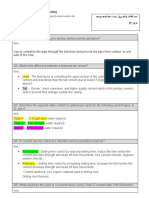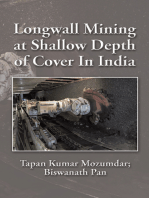Applied Homework 1
Uploaded by
Roba SaidApplied Homework 1
Uploaded by
Roba SaidUniversity of Tripoli
Faculty of Engineering
Petroleum Engineering
Applied Reservoir Engineering
PE453
Name: Roba Said Alrtemi
Student number: 022150834
Due Date: 1/11/2018
H.W :- #1
?Q1.what is worng with the following definition
Reserves are those quantities of petroleum which are anticipated to be "
" recovered from a petroleum accumulation
Solution
Reserves are those quantities of petroleum which are anticipated to be
commercially
recovered from a petroleum accumulation.
Q2.If the average pressure gradient in a region 0.47psi/ft , calculate
the pore pressure in a normally pressurized formation at
7400ft .convert the pressure from psi to KPa, then express the
?pressure in MPa. What is the pressure gradient in KPa/m
SOLUTION
Pw=¿¿
Pressure in formation = 0.47 * 7400 = 3478 psi
?Convert the pressure from psi to KPa
Converting to KPa = 3478 / 0.145 = 23986 KPa
?Convert the pressure from psi to MPa
Kpa Converting to MPa = 23986 / 1000 = 23.99 MPa
?Convert the pressure from psi to KPa/m
Pressure gradient= 0.47 psi/ft (0.47 /
0.145) KPa/ft = 3.2414 KPa/ft
KPa/m )0.3048/ 3.2414( =
KPa/M 10.63 =
Q3.Estimate the compressibility coefficient of a sandstone formation
:that is characterized by a porosity of 0.2,using
a)Hall's correlation
c
f =¿
( 0.21.782 )x 1 0
0.438
−6 −6
=3.606 x10 ¿
b)Newman's correlation
97.32 x 10−6
cf =
¿¿
¿ 2.74 x 10−6 psi−1
Q4.Calculate the reduction the ore volume of a reservoir due to a
pressure drop of 10psi. the reservoir original pore volume is one
*million barrels with an estimated formation compressibikity of 10
−6 −1
10 Psi
SOLUTION
c
f= ( )
1 d Vp
V P dp
=¿¿
= 10=10-6* ( 1
1000000 )∗d V P
10
dv p=100 bbl
Q5.calculate the arithmetic average and thickness-weighted average
:from the following measurements
sample h,ft Ø%, So , % Swc , %
1 1.0 10 75 25
2 1.5 12 77 23
3 1.0 11 79 21
4 2.0 13 74 26
5 2.1 14 78 22
6 1.1 10 75 25
SOLUTION
Arithmetic average
10+ 12+ 11+13+ 14+10
Ø¿ 6
= 11.67 %
Thickness-weighted average
( 1 )( 10 ) + ( 1.5 ) ( 12 ) + ( 1 )( 11 ) + ( 2 ) ( 13 ) + ( 2.1 )( 14 ) +(1.1)(10)
Ø= 1+ 1.5+ 1+ 2+ 2.1+ 1.1
=%12.11
Q6.An oil reservoir exists at its bubble-point pressure of 207bar and
temperature of and gas-oil ratio of 600 scf/STB. The specific gravity
of the solution gas is 0.65.the following additional data are also
:available
Reservoir area=259hectares
Connate water saturation=0.25
Average thickness =10ft
Effective porosity =15%
Calculate the initial oil in place in STB
SOLUTION
141.5
γ° = =0 .8156
42+ 131.5
B°=0.9759+0.00012¿ ¿¿
=bbl/STB1.306
Reservoir area=259hectares
2.47105 acres
1 hectares
Hectares Converting to acres = 259 hectares x
acres 640 =
7758∗640∗10∗0.15∗(1−0.25)
= OIIP
1.306
STB 4276998=
You might also like
- Hourglass Workout Program by Luisagiuliet 276% (21)Hourglass Workout Program by Luisagiuliet 251 pages
- The Hold Me Tight Workbook - Dr. Sue Johnson100% (16)The Hold Me Tight Workbook - Dr. Sue Johnson187 pages
- Read People Like A Book by Patrick King-Edited62% (65)Read People Like A Book by Patrick King-Edited12 pages
- Livingood, Blake - Livingood Daily Your 21-Day Guide To Experience Real Health77% (13)Livingood, Blake - Livingood Daily Your 21-Day Guide To Experience Real Health260 pages
- COSMIC CONSCIOUSNESS OF HUMANITY - PROBLEMS OF NEW COSMOGONY (V.P.Kaznacheev,. Л. V. Trofimov.)94% (212)COSMIC CONSCIOUSNESS OF HUMANITY - PROBLEMS OF NEW COSMOGONY (V.P.Kaznacheev,. Л. V. Trofimov.)212 pages
- Donald Trump & Jeffrey Epstein Rape Lawsuit and Affidavits83% (1016)Donald Trump & Jeffrey Epstein Rape Lawsuit and Affidavits13 pages
- The 36 Questions That Lead To Love - The New York Times94% (34)The 36 Questions That Lead To Love - The New York Times3 pages
- The 36 Questions That Lead To Love - The New York Times95% (21)The 36 Questions That Lead To Love - The New York Times3 pages
- Jeffrey Epstein39s Little Black Book Unredacted PDF75% (12)Jeffrey Epstein39s Little Black Book Unredacted PDF95 pages
- The 4 Hour Workweek, Expanded and Updated by Timothy Ferriss - Excerpt23% (954)The 4 Hour Workweek, Expanded and Updated by Timothy Ferriss - Excerpt38 pages
- 2022 - 04 - 20 - VIVA-B-FIX Line TRG-PolymersNo ratings yet2022 - 04 - 20 - VIVA-B-FIX Line TRG-Polymers15 pages
- Dodge Ram Truck 2005 1500,2500, 3500 Service Repair Manual - Introduction50% (6)Dodge Ram Truck 2005 1500,2500, 3500 Service Repair Manual - Introduction14 pages
- Analysis of Shear Reinforcement For BeamNo ratings yetAnalysis of Shear Reinforcement For Beam28 pages
- International Well Control Forum Surface BOP Kill Sheet-Deviated Well (API Field Units)No ratings yetInternational Well Control Forum Surface BOP Kill Sheet-Deviated Well (API Field Units)3 pages
- John Kevin M. de Castro 16000494: Assignment in Production Technology - MSC in Petroleum EngineeringNo ratings yetJohn Kevin M. de Castro 16000494: Assignment in Production Technology - MSC in Petroleum Engineering8 pages
- Vsip - Info Solucionario Reservorio096 181 PDF FreeNo ratings yetVsip - Info Solucionario Reservorio096 181 PDF Free86 pages
- Residential Building Design Using Excel Program FinalNo ratings yetResidential Building Design Using Excel Program Final22 pages
- University of Tripoli Faculty of Engineering Petroleum EngineeringNo ratings yetUniversity of Tripoli Faculty of Engineering Petroleum Engineering8 pages
- Faculty of Engineering Petroleum Engineering Department: Drilling Engineering I Third StageNo ratings yetFaculty of Engineering Petroleum Engineering Department: Drilling Engineering I Third Stage22 pages
- Chapter 2: Directional & Horizontal Drilling: Evaluation of Horizontal Wells100% (1)Chapter 2: Directional & Horizontal Drilling: Evaluation of Horizontal Wells39 pages
- Lab 3 Porosity Determination Using Helium Porosimeter MethodNo ratings yetLab 3 Porosity Determination Using Helium Porosimeter Method6 pages
- Q1: Why Do We Use Centralizers During Casing Running Operation?100% (1)Q1: Why Do We Use Centralizers During Casing Running Operation?4 pages
- Lecture 5 - Reservoir-Fluid PVT PropertiesNo ratings yetLecture 5 - Reservoir-Fluid PVT Properties44 pages
- Copia de OilProperties - Xls (403) AngelNo ratings yetCopia de OilProperties - Xls (403) Angel3 pages
- Kill Sheet: Prerecorded Infromation Pump Strokes RequiredNo ratings yetKill Sheet: Prerecorded Infromation Pump Strokes Required16 pages
- Well Test Analysis (PETE 4225) Midterm Examination (Open Notes) Date: Thursday, October 15, 2020 Duration: 2 Hours (3:00 PM - 5:00 PM)No ratings yetWell Test Analysis (PETE 4225) Midterm Examination (Open Notes) Date: Thursday, October 15, 2020 Duration: 2 Hours (3:00 PM - 5:00 PM)8 pages
- DP - 5000 0 362 S-135 NC50 6500 3250 2 30 7ftNo ratings yetDP - 5000 0 362 S-135 NC50 6500 3250 2 30 7ft2 pages
- Solution Manual For Applied Petroleum Reservoir Engineering 3rd Edition Terry Rogers 0133155587 9780133155587No ratings yetSolution Manual For Applied Petroleum Reservoir Engineering 3rd Edition Terry Rogers 0133155587 978013315558717 pages
- Formation Testing: Supercharge, Pressure Testing, and Contamination ModelsFrom EverandFormation Testing: Supercharge, Pressure Testing, and Contamination ModelsNo ratings yet
- 7 Volumetirc Dry Gas Reservoirs V2 SolutionNo ratings yet7 Volumetirc Dry Gas Reservoirs V2 Solution23 pages
- Faculty of Engineering Petroleum EngineeringNo ratings yetFaculty of Engineering Petroleum Engineering3 pages
- Faculty of Engineering Petroleum EngineeringNo ratings yetFaculty of Engineering Petroleum Engineering12 pages
- Rubber Design Bellows HT-LT Cat EnginesNo ratings yetRubber Design Bellows HT-LT Cat Engines46 pages
- Full Download of Chemistry The Molecular Nature of Matter 7th Edition Jespersen Test Bank in PDF DOCX Format100% (8)Full Download of Chemistry The Molecular Nature of Matter 7th Edition Jespersen Test Bank in PDF DOCX Format52 pages
- Yokogawa EJA110E General SpecificationsNo ratings yetYokogawa EJA110E General Specifications17 pages
- Fluid Mechanics: Prepared By: Engr. Princess Divine A. DacsigNo ratings yetFluid Mechanics: Prepared By: Engr. Princess Divine A. Dacsig27 pages
- Vessel Calculation Sheet: Internal Pressure DesignNo ratings yetVessel Calculation Sheet: Internal Pressure Design7 pages
- Datasheet Siemens Sitrans p500 Pressure TransmitterNo ratings yetDatasheet Siemens Sitrans p500 Pressure Transmitter27 pages
- Oil Gas Ratings Guide February 2020 LECW2462 27No ratings yetOil Gas Ratings Guide February 2020 LECW2462 2792 pages
- Livingood, Blake - Livingood Daily Your 21-Day Guide To Experience Real HealthLivingood, Blake - Livingood Daily Your 21-Day Guide To Experience Real Health
- COSMIC CONSCIOUSNESS OF HUMANITY - PROBLEMS OF NEW COSMOGONY (V.P.Kaznacheev,. Л. V. Trofimov.)COSMIC CONSCIOUSNESS OF HUMANITY - PROBLEMS OF NEW COSMOGONY (V.P.Kaznacheev,. Л. V. Trofimov.)
- Donald Trump & Jeffrey Epstein Rape Lawsuit and AffidavitsDonald Trump & Jeffrey Epstein Rape Lawsuit and Affidavits
- The 36 Questions That Lead To Love - The New York TimesThe 36 Questions That Lead To Love - The New York Times
- The 36 Questions That Lead To Love - The New York TimesThe 36 Questions That Lead To Love - The New York Times
- Jeffrey Epstein39s Little Black Book Unredacted PDFJeffrey Epstein39s Little Black Book Unredacted PDF
- The 4 Hour Workweek, Expanded and Updated by Timothy Ferriss - ExcerptThe 4 Hour Workweek, Expanded and Updated by Timothy Ferriss - Excerpt
- Dodge Ram Truck 2005 1500,2500, 3500 Service Repair Manual - IntroductionDodge Ram Truck 2005 1500,2500, 3500 Service Repair Manual - Introduction
- International Well Control Forum Surface BOP Kill Sheet-Deviated Well (API Field Units)International Well Control Forum Surface BOP Kill Sheet-Deviated Well (API Field Units)
- John Kevin M. de Castro 16000494: Assignment in Production Technology - MSC in Petroleum EngineeringJohn Kevin M. de Castro 16000494: Assignment in Production Technology - MSC in Petroleum Engineering
- Vsip - Info Solucionario Reservorio096 181 PDF FreeVsip - Info Solucionario Reservorio096 181 PDF Free
- Residential Building Design Using Excel Program FinalResidential Building Design Using Excel Program Final
- University of Tripoli Faculty of Engineering Petroleum EngineeringUniversity of Tripoli Faculty of Engineering Petroleum Engineering
- Faculty of Engineering Petroleum Engineering Department: Drilling Engineering I Third StageFaculty of Engineering Petroleum Engineering Department: Drilling Engineering I Third Stage
- Chapter 2: Directional & Horizontal Drilling: Evaluation of Horizontal WellsChapter 2: Directional & Horizontal Drilling: Evaluation of Horizontal Wells
- Lab 3 Porosity Determination Using Helium Porosimeter MethodLab 3 Porosity Determination Using Helium Porosimeter Method
- Q1: Why Do We Use Centralizers During Casing Running Operation?Q1: Why Do We Use Centralizers During Casing Running Operation?
- Kill Sheet: Prerecorded Infromation Pump Strokes RequiredKill Sheet: Prerecorded Infromation Pump Strokes Required
- Well Test Analysis (PETE 4225) Midterm Examination (Open Notes) Date: Thursday, October 15, 2020 Duration: 2 Hours (3:00 PM - 5:00 PM)Well Test Analysis (PETE 4225) Midterm Examination (Open Notes) Date: Thursday, October 15, 2020 Duration: 2 Hours (3:00 PM - 5:00 PM)
- Solution Manual For Applied Petroleum Reservoir Engineering 3rd Edition Terry Rogers 0133155587 9780133155587Solution Manual For Applied Petroleum Reservoir Engineering 3rd Edition Terry Rogers 0133155587 9780133155587
- Longwall Mining at Shallow Depth of Cover in IndiaFrom EverandLongwall Mining at Shallow Depth of Cover in India
- Formation Testing: Supercharge, Pressure Testing, and Contamination ModelsFrom EverandFormation Testing: Supercharge, Pressure Testing, and Contamination Models
- Full Download of Chemistry The Molecular Nature of Matter 7th Edition Jespersen Test Bank in PDF DOCX FormatFull Download of Chemistry The Molecular Nature of Matter 7th Edition Jespersen Test Bank in PDF DOCX Format
- Fluid Mechanics: Prepared By: Engr. Princess Divine A. DacsigFluid Mechanics: Prepared By: Engr. Princess Divine A. Dacsig
- Vessel Calculation Sheet: Internal Pressure DesignVessel Calculation Sheet: Internal Pressure Design
- Datasheet Siemens Sitrans p500 Pressure TransmitterDatasheet Siemens Sitrans p500 Pressure Transmitter























































































































